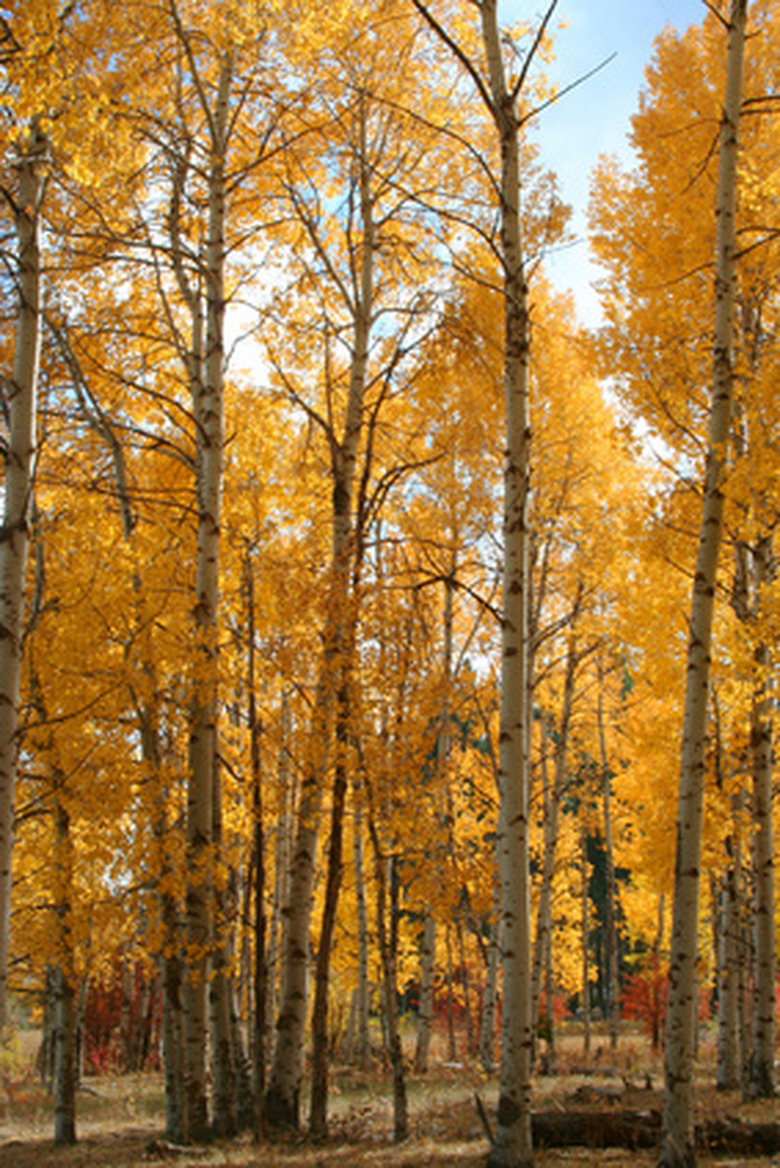How To Stake Quaking Aspen Trees
We may receive a commission on purchases made from links.
Quaking aspens, with their green, fluttering leaves that turn a golden yellow in the fall, make a great addition to any home landscape. The tall, slender tree can grow up to 40 feet tall and can be grown in most well-drained soils. For the quaking aspen to develop a strong trunk and root system, only stake the trees if they will be planted in an area with strong winds, or will be in a location where they might get knocked over by children or pets.
Step 1
Drive a stake about 18 to 24 inches into the ground, using a hammer or mallet. If the tree will be in a high-traffic area, make sure the top of the stake is at least 3 feet above the ground. This will make the stake and webbing more visible so passers-by can avoid them.
Step 2
Connect the tree to the stake, using 3-inch webbing, polyethylene strips, nylon stockings or other non-restrictive material. Wrap the strap loosely around the midpoint of the tree and staple the ends to the stake. If the strap or webbing is too tight, it will constrict the tree's movement, which weakens the trunk and root system.
- Quaking aspens, with their green, fluttering leaves that turn a golden yellow in the fall, make a great addition to any home landscape.
- For the quaking aspen to develop a strong trunk and root system, only stake the trees if they will be planted in an area with strong winds, or will be in a location where they might get knocked over by children or pets.
Step 3
Remove the stake and webbing as soon as possible. A year is enough time for a small tree to be staked. Larger trees might need up to two years of staking.
Quaking Aspen Tree Care
Start taking care of your quaking aspen by planting it in a location where it can thrive. These aspens prefer fully sunny locations, although they will tolerate some partial shade. Quaking aspens adapt well to nearly any soil condition, thriving in rocky, loamy, sandy and clay soils. Promote a healthier root system by watering your tree deeply only when the surrounding soil feels dry to the touch. Quaking aspens attract various disease organisms, including ink spot pathogens (Ciborinia spp.) Marssonina leaf spot first appears as small, dark brown spots ringed with yellow. The spots merge to create large areas of black and deadened leaf tissue. A single mother tree can start a small aspen grove, which causes problems if you have a small yard. Prevent spreading fungal diseases by pruning out and destroying any diseased limbs and foliage.
- Remove the stake and webbing as soon as possible.
- Promote a healthier root system by watering your tree deeply only when the surrounding soil feels dry to the touch.
Things Needed
- Wooden stakes
- Hammer or mallet
- Staple gun
- Strapping material
Tip
For most young quaking aspens, one stake on the windward side is sufficient. If the diameter of the trunk is greater than 3 inches, more stakes may be needed. When staking your tree, don't use any material that would cut into the trunk or damage it, such as garden hose, wire or fishing line.
References
- Utah State University Cooperative Extention: Quaking Aspen
- The Home Depot: Staking a Tree
- Cal Poly Urban Forest Ecosystems Institute: Quaking Aspen
- Lady Bird Johnson Wildflower Center: Populus Tremuloides
- Washington State University Clark County Extension: Quaking Aspen
- Utah State University Extension: Quaking Aspen
- Utah State University Extension: Efficient Irrigation of Trees and Shrubs
- Colorado State University, Colorado State Forest Service: Aspen and Poplar Leaf Spots
- University of California Statewide Integrated Pest Management Program: Leaf Spot Diseases
